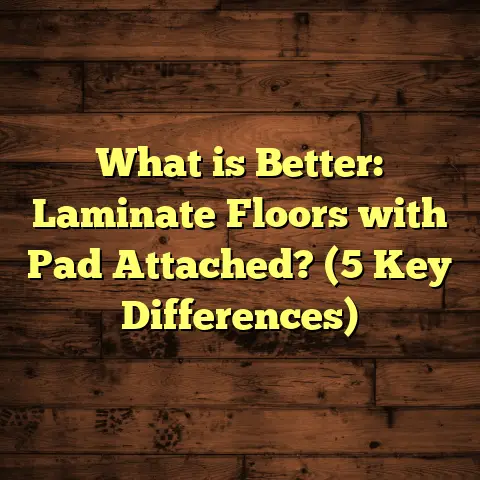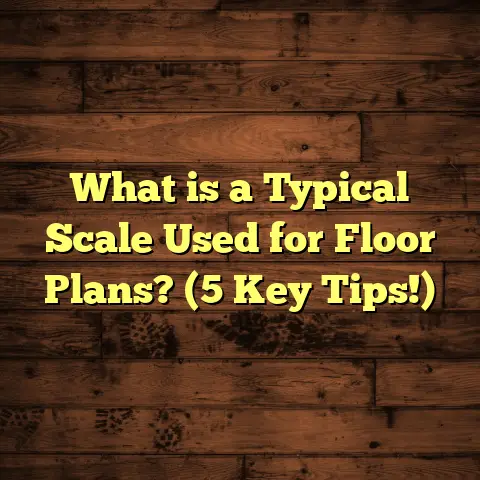What is the Most Popular Flooring for Bedrooms? (5 Trendy Options)
Blending styles in home design has become a favorite way to create spaces that feel personal and unique. When I talk about bedrooms, mixing textures, colors, and materials can really set the mood. One of the biggest decisions you’ll make in this mix is flooring. The floor sets the foundation for everything else, literally and visually. So, what is the most popular flooring for bedrooms? Let me walk you through five trendy options that many homeowners, including myself, have found perfect for their personal spaces.
What Is the Most Popular Flooring for Bedrooms?
When you ask, “What is the most popular flooring for bedrooms?” you’re really asking about types of flooring that balance comfort, style, durability, and cost. Bedrooms need flooring that feels cozy underfoot but also looks good with a variety of décor styles.
Over the years, I’ve worked on many bedroom projects and seen firsthand how different flooring choices impact the room’s vibe and functionality. Popular choices tend to be soft, warm, and easy to maintain. But popularity also depends on where you live, your budget, and how much time you want to spend on upkeep.
Let’s explore five flooring types that have been consistently popular in bedrooms across different regions:
1. Hardwood Flooring – Classic Warmth That Lasts
Why hardwood? The natural look of hardwood floors adds warmth and elegance to any bedroom. I’ve installed oak hardwood in rooms as small as 120 square feet and as large as 350 square feet. Depending on the wood species and finish, prices usually range from $6 to $12 per square foot for materials alone, with installation adding $3 to $8 per square foot.
Hardwood floors can last decades when properly cared for. In my experience, solid hardwood works best in climates with less humidity because it can expand and contract with moisture changes. I once helped a client in Denver select maple hardwood because it holds up well in dry mountain air.
Fun fact: Hardwood flooring often increases home resale value by about 2-3%. It’s an investment that pays off if you plan to sell your house within 5 years.
My Hardwood Flooring Experience
Years ago, I remodeled a master bedroom for a couple in Portland. They wanted something timeless but not too dark or light. We chose white oak with a matte finish—the floors looked stunning with their mid-century modern furniture.
Installation took about three days for their 250-square-foot room because we had to prep the subfloor well. The client said it was worth every penny; she loved waking up barefoot on smooth wood each morning.
Hardwood Maintenance Tips
Hardwood needs some care to stay beautiful:
- Cleaning: Use a soft broom or microfiber mop. Avoid soaking with water.
- Humidity: Keep indoor humidity between 30-50% to prevent warping.
- Protection: Use felt pads under furniture legs.
From my experience, these steps keep hardwood floors looking fresh for decades.
2. Carpet – The Ultimate Comfort Zone
Carpet still remains a top choice for bedrooms because of its softness. I love how carpets can make a bedroom feel like a cozy retreat. When I worked on a 200-square-foot master bedroom renovation in Minneapolis, we installed plush nylon carpet at roughly $3 to $7 per square foot including padding and installation.
Carpet offers sound insulation and warmth—perfect if you live somewhere cold or noisy. It’s also great if you have kids or pets because it cushions falls.
However, carpet does require regular maintenance—vacuuming at least once a week and deep cleaning every 12 to 18 months. Some people worry about allergens, but using hypoallergenic carpet fibers and good ventilation helps a lot.
Personal Carpet Story
I once recommended carpet for a young family with two toddlers in Boston. Their bedroom was about 180 square feet. They wanted something soft and safe for their kids. We installed wool blend carpet with thick padding underneath.
The family loved how comfy it felt and how it muffled city noise outside their apartment. They invested around $4 per square foot installed and were happy with the warmth it provided during harsh winters.
Carpet Pros and Cons
Pros:
- Soft and warm underfoot.
- Good sound absorber.
- Wide variety of colors and textures.
- Usually affordable upfront.
Cons:
- Can stain easily.
- Requires frequent vacuuming.
- May trap allergens if not cleaned well.
- Typically lasts 5-10 years depending on wear.
In my experience, carpet is perfect for bedrooms where comfort is priority over longevity.
3. Luxury Vinyl Plank (LVP) – Style Meets Practicality
Luxury Vinyl Plank flooring has exploded in popularity over the last five years. It mimics the look of hardwood but is more budget-friendly and water-resistant—ideal if you want wood-look floors with less hassle.
In my projects around Phoenix, LVP costs about $2 to $5 per square foot for materials. Installation is another $1.50 to $3 per square foot. It installs quickly; I’ve finished bedroom floors in under a day for 150-square-foot rooms.
One homeowner loved LVP because she could clean it easily with a damp mop and it handled her humid basement bedroom perfectly.
Why Choose LVP?
I installed LVP in my sister’s guest bedroom last year in Austin, Texas. The room was 140 square feet with an uneven concrete subfloor. LVP’s flexibility allowed for floating installation without much subfloor prep.
She liked that the flooring was waterproof because her dog occasionally brought in wet paws. She spent around $600 total for materials and installation, which was a big saving compared to hardwood or engineered wood.
LVP Durability and Care
LVP is surprisingly tough against scratches and stains. Cleaning is simple—just sweep or mop with a non-abrasive cleaner.
Its durability makes it ideal for homes with pets or kids who might spill drinks or track dirt inside.
4. Engineered Hardwood – The Best of Both Worlds
Engineered hardwood combines real wood veneer with plywood backing, making it more stable than solid hardwood in fluctuating climates like Florida or Seattle. It looks just like solid hardwood but handles moisture better.
Prices for engineered hardwood range from $4 to $10 per square foot, with installation costs similar to solid hardwood. I’ve installed engineered oak floors in several bedrooms ranging from 100 to 300 square feet.
The installation time is similar to hardwood—usually one or two days depending on room size and subfloor prep.
Engineered Hardwood Case Study
A couple in Seattle wanted real wood floors but had concerns about moisture from seasonal rains. We selected engineered hickory flooring that was both durable and resistant to humidity changes. The 220-square-foot bedroom took two days to install at about $9 per square foot total cost.
They were happy with how natural it looked and felt underfoot but appreciated the stability engineered hardwood provided.
Benefits Over Solid Hardwood
- Better moisture resistance.
- Can be installed over radiant heating systems.
- Usually thinner planks mean quicker installation.
- Can be sanded and refinished fewer times than solid hardwood but still offers longevity.
5. Cork Flooring – Soft, Sustainable, and Quiet
Cork is a quieter alternative that’s gaining traction for its eco-friendly benefits and soft feel underfoot. I installed cork in a guest bedroom last year; the room was about 180 square feet.
Cork costs between $4 and $8 per square foot, including installation. It’s naturally insulating and hypoallergenic, which can be great for allergy sufferers. Plus, it has a unique look that adds character without overwhelming the room.
The only downside? Cork can dent if you drag heavy furniture without protection.
My Cork Installation Experience
For a client in Portland who wanted something different but comfortable, cork was perfect. The natural patterns added warmth and texture.
Installation took one full day for their medium-sized room (around 160 sq ft). They were pleased with the sound dampening effect—ideal for their upstairs bedroom above a noisy living room.
Cork Flooring Maintenance Tips
- Avoid sharp heels or dragging heavy furniture.
- Clean spills immediately.
- Use gentle cleaners designed for cork.
- Refinish the surface every few years with a sealant to keep it looking fresh.
Factors That Affect Bedroom Flooring Choices
You might wonder why some floors work better than others in certain places or situations. Here are some key points I’ve learned through years of experience:
- Climate: Humidity levels matter. Solid hardwood can warp in moist environments unless properly sealed or acclimated.
- Budget: Carpets are generally cheaper upfront but may cost more over time due to maintenance.
- Lifestyle: Families with kids might prefer carpet or cork for safety and comfort.
- Maintenance: Busy people lean toward LVP or engineered hardwood for easy cleaning.
- Resale Value: Hardwood floors tend to appeal more to buyers if selling is planned within 5 years.
A Deeper Look at Costs and Budgets
Cost is always one of the first questions I get asked. Here’s a detailed breakdown based on my recent projects:
| Flooring Type | Material Cost ($/sq ft) | Installation Cost ($/sq ft) | Total Cost Range ($/150 sq ft) | Timeframe (Days) | Lifespan (Years) |
|---|---|---|---|---|---|
| Hardwood | 6 – 12 | 3 – 8 | 1350 – 3000 | 2 – 3 | 30+ |
| Carpet | 2 – 5 | 1 – 2 | 450 – 1050 | 1 | 5 – 10 |
| Luxury Vinyl Plank | 2 – 5 | 1.5 – 3 | 525 – 1200 | <1 | 15+ |
| Engineered Hardwood | 4 – 10 | 3 – 8 | 1050 – 2700 | 1 – 2 | 20+ |
| Cork | 4 – 8 | 3 – 5 | 1050 – 1950 | 1 | 10 -15 |
These numbers give you a realistic picture of what budgeting looks like across options for an average bedroom size around 150 square feet.
How Long Does Bedroom Flooring Installation Take?
Timeframes vary based on flooring type, room size, subfloor condition, and prep work needed:
- Hardwood: Usually takes two to three days including sanding and finishing.
- Carpet: One day is typical if no major subfloor repairs are needed.
- LVP: Can often be completed within a day due to simple click-lock installation.
- Engineered Hardwood: Similar to solid hardwood but sometimes quicker due to thinner planks.
- Cork: One day usually suffices unless complex patterns are involved.
Flooring Trends I’ve Seen Changing Over Time
Over my career, I noticed some shifts in bedroom flooring trends:
- About ten years ago, carpet dominated bedrooms across most regions due to its affordability and comfort.
- Hardwood made a strong comeback as homeowners wanted more natural material inside their homes.
- In recent years, luxury vinyl plank has surged because it offers wood looks without high costs or maintenance.
- Eco-friendly options like cork have gained interest among conscious consumers seeking sustainable materials.
I keep an eye on what clients request nowadays—many want versatile flooring that blends well with multiple décor styles so they don’t feel locked down by trends.
Unique Insights from My Projects
Case Study #1: Combining Flooring Types in One Bedroom
I once worked on a project where the client wanted hardwood near the bed but carpet around the sitting area inside a large bedroom (about 350 sq ft). This mix created zones without walls, which felt modern yet cozy.
Installation took four days total because we had to carefully transition between flooring types using special threshold strips to avoid tripping hazards.
The client loved how this approach gave warmth underfoot while keeping noise down where they read or relaxed.
Case Study #2: Flooring Choice Impact on Room Temperature
In Phoenix’s hot climate, one homeowner chose cork for thermal insulation properties in their upstairs bedroom (~160 sq ft). The cork helped regulate temperature better than tile or wood alone would have.
They noticed lower energy bills during summer months due to reduced air conditioning use—a practical benefit not everyone thinks about when picking bedroom flooring!
How To Choose Based On Your Bedroom Size?
Room size plays a role too:
- Small bedrooms (under 120 sq ft): Carpets or LVP work great because they can make small spaces feel cozy without overwhelming them visually.
- Medium bedrooms (120–250 sq ft): Almost any option fits well; engineered hardwood or cork add character without breaking budgets.
- Large bedrooms (over 250 sq ft): Hardwood floors shine here since they create a luxurious feel across bigger spaces; multiple zones or rugs can add softness as needed.
Installation Tips From My Experience
If you’re planning DIY or hiring pros, here are some pointers:
- Always measure your room at least twice before ordering materials—include closets and entryways if part of the flooring plan.
- Account for waste: typically add about 5-10% extra material depending on pattern complexity.
- Prepare your subfloor: it must be clean, dry, level within tolerance (usually ±3/16 inch over a 10-foot span).
- Hire certified installers if possible—quality workmanship affects longevity and appearance greatly.
Maintenance: Keeping Your Bedroom Flooring Looking Great
Each flooring type requires its own care routine:
| Flooring Type | Cleaning Frequency | Deep Cleaning Needed | Special Care Tips |
|---|---|---|---|
| Hardwood | Weekly sweeping/mopping | Every few years refinishing | Avoid water pooling; use furniture pads |
| Carpet | Weekly vacuuming | Every 12–18 months | Use stain protectors; remove spills fast |
| LVP | Weekly sweeping/mopping | As needed | Use gentle cleaners; avoid wax/polish |
| Engineered Hardwood | Weekly sweeping/mopping | Every few years refinishing | Control humidity; avoid abrasive tools |
| Cork | Weekly sweeping/mopping | Every few years resealing | Protect from dents; clean spills immediately |
Flooring Color & Texture Trends That Suit Bedrooms
Color choice influences mood:
- Light woods or pale cork create airy spaces.
- Dark woods add drama but can make rooms feel smaller.
- Neutral carpets work well with colorful bedding or walls.
Texture matters too—smooth finishes feel sleek; distressed woods add rustic charm; plush carpets bring softness.
One client chose hand-scraped engineered hardwood because it masked scratches better than smooth finishes—a smart choice if pets are around!
How Flooring Influences Bedroom Acoustics
Sound absorption is often overlooked but crucial in bedrooms:
- Carpet and cork excel at dampening footsteps and ambient noise.
- Hardwood and LVP reflect sound more but can be softened with area rugs.
A good acoustic environment helps improve sleep quality—something I always point out during consultations.
Why I Favor Personalized Flooring Solutions
Every home is different—what worked well for one client might not suit another’s lifestyle or style preferences.
I always start by asking:
- What’s your budget?
- Do you want natural materials?
- How much time do you have for maintenance?
- Are there pets or kids?
- What climate are you in?
From there, we narrow down options that fit both functionally and aesthetically.
Final Thoughts (No Summary Here!)
Choosing bedroom flooring involves balancing comfort, style, durability, budget, and maintenance preferences. Hardwood remains beloved for its timeless appeal; carpet keeps its place as comfort king; LVP impresses with practicality; engineered hardwood blends beauty with stability; cork offers softness plus sustainability.
If you want help sizing your room, budgeting costs using tools like FloorTally (which I often recommend), or advice on installation timing—I’m happy to guide you step by step!
Feel free to reach out anytime—I’m here to share what I’ve learned after years of transforming bedrooms into relaxing sanctuaries one floor at a time!





